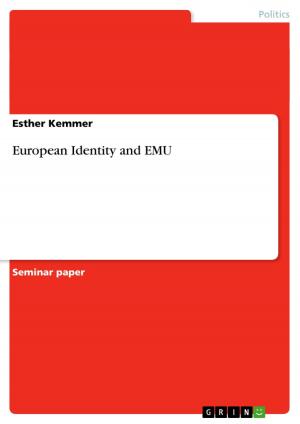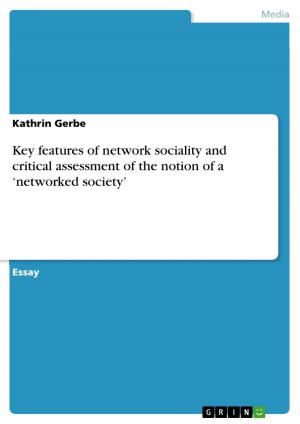New Meets Old: Hawthorne's Representation of America and Europe in The Marble Faun
Nonfiction, Entertainment, Drama, Anthologies| Author: | Tonia Fondermann | ISBN: | 9783638224147 |
| Publisher: | GRIN Publishing | Publication: | October 20, 2003 |
| Imprint: | GRIN Publishing | Language: | English |
| Author: | Tonia Fondermann |
| ISBN: | 9783638224147 |
| Publisher: | GRIN Publishing |
| Publication: | October 20, 2003 |
| Imprint: | GRIN Publishing |
| Language: | English |
Seminar paper from the year 2003 in the subject American Studies - Literature, grade: 1,3 (A), Ruhr-University of Bochum (Philology, English Seminar), course: Reading Hawthorne's Romance, 14 entries in the bibliography, language: English, abstract: [...] In my analysis I want to show that Hawthorne represents America and Europe as opposites and turns them into opponents in the fight of America versus Europe. In the course of this paper I would like to find out about the reasons for his contrary representations of the two continents. Furthermore I want to uncover the purpose of Hawthorne's different representations. The thesis, which I want to prove here, is that Hawthorne deals with the American feeling of cultural inferiority towards Europe and its eventual overcoming by means of the Myth of America. The characters in The Marble Faun are created according to the American and European stereotypes, which the myth makes use of, and serve as means for expressing the conflict. In this context, I want to show that The Marble Faun is a pro-America romance. Pro-America because Hawthorne is conform to the Myth of America and praises innocence, a virtue which America claims exclusively for itself. Based on the claim of innocence America claims leadership, which is supported by Hawthorne. First of all I will deal with the roots of the tensions between Europe and America and the traditional stereotypical treatment of them. Then I will explain the Myth of America and the reason for its invention. After these two introductory parts I want to concern myself with the question of how Hawthorne transferred the topic of America versus Europe into a story. Proceeding from the assumption that the Myth of America served as a basis, I want to deal more closely with the stereotypes and point out the parallels to the main characters. Coming from the stereotypes I will take a closer look at the female figures, Miriam and Hilda. I will show that they represent the stereotypical Europe and America most perfectly. The American character Hilda is for me of great interest because she constitutes the moral center of the romance. Moreover Hawthorne uses mostly her figure to carry out the pro-America tendencies of the book. By looking at Hawthorne's treatment of Hilda I will demonstrate the strong orientation at the Myth of America and his praise of the American virtue. In the last chapter I will come back to the American feelings of cultural inferiority towards Europe. My intention is to show how Hawthorne deals with the problem and how he uses the Myth of America to turn the American characters' cultural inferiority into overall superiority.
Seminar paper from the year 2003 in the subject American Studies - Literature, grade: 1,3 (A), Ruhr-University of Bochum (Philology, English Seminar), course: Reading Hawthorne's Romance, 14 entries in the bibliography, language: English, abstract: [...] In my analysis I want to show that Hawthorne represents America and Europe as opposites and turns them into opponents in the fight of America versus Europe. In the course of this paper I would like to find out about the reasons for his contrary representations of the two continents. Furthermore I want to uncover the purpose of Hawthorne's different representations. The thesis, which I want to prove here, is that Hawthorne deals with the American feeling of cultural inferiority towards Europe and its eventual overcoming by means of the Myth of America. The characters in The Marble Faun are created according to the American and European stereotypes, which the myth makes use of, and serve as means for expressing the conflict. In this context, I want to show that The Marble Faun is a pro-America romance. Pro-America because Hawthorne is conform to the Myth of America and praises innocence, a virtue which America claims exclusively for itself. Based on the claim of innocence America claims leadership, which is supported by Hawthorne. First of all I will deal with the roots of the tensions between Europe and America and the traditional stereotypical treatment of them. Then I will explain the Myth of America and the reason for its invention. After these two introductory parts I want to concern myself with the question of how Hawthorne transferred the topic of America versus Europe into a story. Proceeding from the assumption that the Myth of America served as a basis, I want to deal more closely with the stereotypes and point out the parallels to the main characters. Coming from the stereotypes I will take a closer look at the female figures, Miriam and Hilda. I will show that they represent the stereotypical Europe and America most perfectly. The American character Hilda is for me of great interest because she constitutes the moral center of the romance. Moreover Hawthorne uses mostly her figure to carry out the pro-America tendencies of the book. By looking at Hawthorne's treatment of Hilda I will demonstrate the strong orientation at the Myth of America and his praise of the American virtue. In the last chapter I will come back to the American feelings of cultural inferiority towards Europe. My intention is to show how Hawthorne deals with the problem and how he uses the Myth of America to turn the American characters' cultural inferiority into overall superiority.















